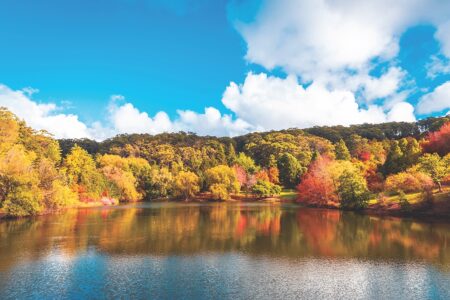Forestry official shares thoughts on foliage season

Mount Lofty Botanic Garden by the pond on a day during autumn season
Although the show of color on leaves this fall should be “vivid” according to Ryan Reed from the Department of Conservation and Natural Resources’ (DCNR) Bureau of Forestry, it could be “quick.” So, don’t wait to get out there and do some leaf peeping.
“I’m getting a lot of reports that people are seeing early color now throughout all regions of the state,” Reed said.
“I’ve seen it in my own travels as well, and in and around where I live. Last week, I was in State College for a conference, and I couldn’t believe all the color on the trip from Southeastern Pennsylvania to the central part of the state — just that Route 322 corridor was pretty striking, some of the color that you can see from the roadside,” he added.
He noted that foresters in the northern tier have even been sending him photos of early color on the trees.
“I have friends who travel to various cabins and places in the mountainous regions of Pennsylvania, and are just in awe of some of the colors that you can see already,” he said.
“It’s actually come on so strong and so quickly that I’ve moved up the first week of the fall foliage report for this year. I was originally planning on releasing the first fall foliage report on the second of October, but I’m like I’ve got to be able to capture a lot of the color, so I moved that up to the 25th (of September) and I’m even thinking that I might have done better to move it up even to this week-that would have been the 18th. But I think I’m going to strike the right balance here with capturing the majority of the season,” he said.
What is happening, Reed, who is the department’s “foliage guru”, said, is that the earlier onset of color this year has been brought on by the lack of rain this summer.
“I do think that with the dryness, if the dryness continues, it could really affect the longevity of the season. The leaves just don’t like to hold on when it’s been so dry,” he explained.
“I do kind of expect it to be a little quicker onset, maybe shorter duration of a season. But people should expect it to be vivid. Typically during dry years, the fall color is really beautiful,” he said.
“So if I had to tell someone, don’t miss it when you see those peak forecasts. You know, take that very seriously if you’re somebody who’s enthusiastic about the fall color, you know you want to get out there and experience it. It probably won’t last too long,” he added.
Ever since the middle of summer, the amount of daylight has been getting less. On Sept. 22, the autumnal equinox will occur when the amount of daylight and darkness are equal. This decreased light is linked to the leaves changing color.
“When you think about the green, you might remember that the green is tied into the process called photosynthesis, and without the chlorophyll, that’s green, then the tree cannot harvest the energy from the sun. And so the green is really about sun energy,” he explained.
“When there’s less sun energy, because the day lengths are getting shorter, then it’s less economical to make that chlorophyll. Chlorophyll has to be made, because it does degrade. So it’s a balance. The tree has to strike a balance. And they say, ‘OK, well, I’m going to make this chlorophyll, then it better be worth it in terms of energy for growth and for storage in the roots and so on.’ As soon as that balance stops being economical for the tree, then it’ll stop producing chlorophyll. And then you’ll start to see the green fading, and then those underlying pigments will start to show whether they’re yellow or red, (or) orange,” he said
The state’s dominant forest type is oak, hickory forest, and then the second most dominant type is the northern hardwood forest, which Reed said are both fantastic for fall color.
“When you think of Northern hardwoods, you probably think of the quintessential maple. We have lots of species of maple in Pennsylvania, particularly the sugar maple and the red maple, which are real fall foliage standouts,” he said.
“Another part of the northern hardwood community that’s a real standout would be the birches and the cherries. They’re typically yellow, and add a lot of bright yellow to the canopies. But going back to the oak hickory forest, there’s a lot of the deeper shades you’ll find in the oaks. So red oak, scarlet oak, black oak, produce those really deep reds of scarlet reds. And then, you know, the hickories are yet another one that produces a lot of vivid yellow or even orange. And there’s also a lot of orange contributors too,” he said.
“It’s really awesome that we get such a mixture and diversity of species that give color in our forest.”
Reed stressed that people should realized “how blessed we are in Pennsylvania with the amount of public land that we have.”
“Just between DCNR, the Bureau of forestry, and the Bureau of State Parks, we manage over two and a half million acres of forest land, and these lands are scattered all across Pennsylvania, so they’re very, very accessible to most Pennsylvanians,” he said.
“We encourage people to get out and experience the forest. And while they do that, and we know it’s a very trendy topic, we try to make sure that we are using this moment to tell people about how important our forests really are. Not only are they beautiful, (but) they are a source of eco-tourism and economic activity. They are a source of jobs for about 60,000 people in Pennsylvania in terms of the forest product industries. They provide homes for wildlife. They provide places for recreation. Our forests are immensely valuable to Pennsylvania,” Reed said.
“So use this moment in time to appreciate our forests, but don’t forget all the other values that our forests provide,” he added.


